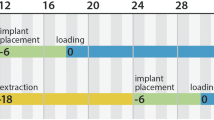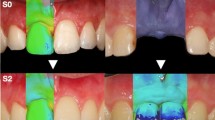Abstract
Objective
To characterize osseointegration as the percent of bone-implant contact (%BIC) along the surface (0.0 mm) as well as at surface profiles 0.5 mm and 1.0 mm lateral to the implant, determining any differences between early occlusally loaded and non-loaded implants.
Material and methods
In ten adult female baboons, 120 dental implants were randomly placed in opposing mandibular and maxillary locations. Eighty sites had two groups of healing (no load) of either 1 (n = 40) or 2 (n = 40) months leading to 3 months of functional loading. These sites received full acid-etched surface implants. The 40 control implants represented healing only periods (no load) for 1 (n = 10), 2 (n = 10), 4 (n = 10), and 5 (n = 10) months. These implants were of a vertically split surface texture design (acid-etched and machined). Block sections and photomicrographs were obtained. Blinded histometric analyses determined the %BIC via a superimposed template.
Results
The unloaded groups (1, 2, and 4 months) had higher %BIC compared to the 5-month group (p < 0.0001). The loaded groups exhibited mean bone densities of 59.2% and 55.5% (1-month healing at 0.5 mm and 1.0 mm, respectively) and 61.0% and 57.1% (2-month healing at 0.5 mm and 1.0 mm, respectively) with no significant difference between healing time (p = 0.4118).
Conclusion
There was a lateral increase in %BIC in the loaded compared to unloaded groups.
Clinical Relevance.
The decrease in bone densities at the 5-month unloaded group suggests that there is a critical earlier time period when dental implants should be placed into functional load.











Similar content being viewed by others
References
Lekholm U and Zarb GA. (1985) Patient selection. In: Branemark PI, Zarb GA & Albrektsson T, eds. Tissue Integrated Prosthesis. Osseointegration in Clinical Dentistry. Chicago: Quintessence, 199-209
Gulsahi A, Paksoy CS, Ozden S, Kucuk NO, Cebeci AR, Genc Y. (2010) Assessment of bone mineral density in the jaws and its relationship to radiomorphometric indices. Dentomaxillofac Radiol 39(5):284–289. Erratum in: Dentomaxillofac Radiol 2013;42(8):20139012.
Bruno V, Berti C, Barausse C, Badino M, Gasparro R, Ippolito DR, Felice P (2018) Clinical relevance of bone density values from CT related to dental implant stability: a retrospective study. Biomed Rese Int 2018:6758245
Trisi P, Lazarra R, Rao W, Rebaudi A (2002) Bone-implant contact and bone quality: evaluation of expected and actual bone contact on machined and Osseotite implant surfaces. Int J Periodontics Restorative Dent 22:534–545
Trisi P, Berardini M, Falco A, Podaliri VM (2015) Effect of implant thread geometry on secondary stability, bone density, and bone-to-implant contact: a biomechanical and histological analysis. Implant Dent 24(4):384–391
Kohles SS (2000) Applications of an anisotropic parameter to cortical bone. J Mater Sci Mater Med 11(4):261–265
Kohles SS, Martinez DA (2000) Elastic and physicochemical relationships within cortical bone. J Biomed Mater Res 49(4):479–488
Kohles SS, Roberts JB (2002) Linear poroelastic cancellous bone anisotropy: trabecular solid elastic and fluid transport properties. J Biomech Eng 124(5):521–526
Albrektsson T, Sennerby L (1990) Direct bone anchorage of oral implants: clinical and experimental considerations of the concept of osseointegration. Int J Prosthodontol 13:30–41
Kohles SS, Clark MB, Brown CA, Kenealy JN (2004) Direct assessment of profilometric roughness variability from typical implant surface types. Int J Oral Maxillofac Implants 19(4):510–516
Fickl S, Stappert CFJ, Kohles SS (2021) Crestal bone loss due to abutment manipulation and an internal silver deposition implant design in a canine model. Clin Oral Investig 25(2):515–523. https://doi.org/10.1007/s00784-020-03416-z
Balshi TJ, Wolfinger GJ (1997) Immediate loading of Branemark implants in edentulous mandibles: a preliminary report. Implant Dent 6:83–88
Tarnow DP, Emtiaz S, Classi A (1997) Immediate loading of threaded implants at stage 1 surgery in edentulous arches: ten consecutive case reports with 1- to 5-year data. Int J Oral Maxillofac Implants 12:319–324
Vernino AR, Kohles SS, Holt RA Jr, Lee HM, Caudill RF, Kenealy JN (2002) Dual-etched implants loaded after 1-and 2-month healing periods: a histologic comparison in baboons. Int J Periodontics Restorative Dent 22:3–10
Piatelli A, Ruggeri A, Franchi M, Romasco N, Trisi P (1993) A histologic and histomorphometric study of bone reactions to unloaded and loaded non-submerged single implants in monkeys: a pilot study. J Oral Implantol 19:314–320
Piatelli A, Paolantonio M, Corigliano M, Scarano A (1997) Immediate loading of titanium plasma-sprayed screw-shaped implants in man: a clinical and histological report of two cases. J Periodontol 68:591–597
Sheridan RA, Decker AM, Plonka AB, Wang HL (2016) The role of occlusion in implant therapy: a comprehensive updated review. Implant Dent 25(6):829–838. https://doi.org/10.1097/ID.0000000000000488
Isidor F (1997) Histological evaluation of peri-implant bone at implants subjected to occlusal overload or plaque accumulation. Clin Oral Implants Res 8:1–9
Stach RM, Kohles SS (2003) A meta-analysis examining the clinical survivability of machined-surfaced and osseotite implants in poor-quality bone. Implant Dent 12(1):87–96. https://doi.org/10.1097/01.id.0000042507.37401.6f
Feldman S, Boitel N, Weng D, Kohles SS, Stach RM (2004) Five-year survival distributions of short-length (10 mm or less) machined-surfaced and Osseotite implants. Clin Implant Dent Relat Res 6(1):16–23
Barbier L, Schepers E (1997) Adaptive bone remodeling around oral implants under axial and non-axial loading conditions in the dog mandible. Int J Oral Maxillofac Implants 12:215–223
Carr AB, Gerard DA, Larson PE (1996) The response of bone in primates around unloaded dental implants supporting prostheses with different levels of fit. J Prosthetic Dentistry 76:500–509
Hürzeler MB, Quinones CR, Kohal RJ, Rohde M, Strub JR, Teuscher U, Caffesse RG (1998) Changes in peri-implant tissues subjected to orthodontic forces and ligature breakdown in monkeys. J Periodontol 69(3):396–404
Gotfredsen K, Berglundh T, Lindhe J (2001) Bone reactions adjacent to titanium implants subjected to static load: a study in the dog. (I). Clin Oral Implants Res 12:1–8
de Calais CD, Bordin D, Piattelli A, Iezzi G, Negretto A, Shibli JA (2021) Lateral static overload on immediately restored implants decreases the osteocyte index in peri-implant bone: a secondary analysis of a pre-clinical study in dogs. Clin Oral Investig 25(5):3297–3303. https://doi.org/10.1007/s00784-020-03662-1
Kuroshima S, Yasutake M, Tsuiki K, Nakano T, Sawase T (2015) Structural and qualitative bone remodeling around repetitive loaded implants in rabbits. Clin Implant Dent Relat Res 17(Suppl 2):e699-710. https://doi.org/10.1111/cid.12318
Granato R, Bergamo ETP, Witek L, Bonfante EA, Marin C, Greenberg M, Kurgansky G, Coelho PG (2020) Clinical, histological, and nanomechanical parameters of implants placed in healthy and metabolically compromised patients. J Dent 100:103436. https://doi.org/10.1016/j.jdent.2020.103436
Anchieta RB, Guimarães MVM, Suzuki M, Tovar N, Bonfante EA, Atria P, Coelho PG (2018) Nanomechanical assessment of bone surrounding implants loaded for 3 years in a canine experimental model. J Oral Maxillofac Surg 76(1):71–79. https://doi.org/10.1016/j.joms.2017.08.016
Gray JL, Vernino AR (2004) The interface between retained roots and dental implants: a histologic study in baboons. J Periodontol 75(8):1102–1106
Gray JL, Vernino AR, Towle HJ (2005) A comparison of the clinical and histologic crestal bone level measurements adjacent to dental implants in the baboon. Int J Periodontics Restorative Dent 25(6):623–628
Tull LT. (2003) Measuring bone density at distances lateral to the bone-implant interface with various stages of loading: a histomorphometric analysis in the baboon. Master of Science Thesis (LL Ryan). University of Florida.
Bain CA, Weng D, Meltzer A, Kohles SS, Stach RM. (2002) A meta-analysis evaluating the risk for implant failure in patients who smoke. Compend Contin Educ Dent 23(8):695–699, 702, 704 passim; quiz 708.
Donath K. (1998) Preparation of histologic sections. Exakt-Kuzer, Norderstedt, Germany.
Heiner JP, Manley PA, Kohles SS, Ulm MJ, Bogart L, Vanderby R Jr (1994) Ingrowth reduces implant-to-bone relative displacements in canine acetabular prostheses. J Orthop Res 12(5):657–664. https://doi.org/10.1002/jor.1100120508
Manley PA, Vanderby R Jr, Kohles SS, Markel MD, Heiner JP (1995) Alterations in femoral strain, micromotion, cortical geometry, cortical porosity, and bony ingrowth in uncemented collared and collarless prostheses in the dog. J Arthroplasty 10(1):63–73. https://doi.org/10.1016/s0883-5403(05)80102-0
Chang MC, Ko CC, Liu CC, Douglas WH, DeLong R, Seong WJ, Hodges J, An KN (2003) Elasticity of alveolar bone near dental implant-bone interfaces after one month’s healing. J Biomech 36(8):1209–1214
Rivara F, Macaluso GM, Toffoli A, Calciolari E, Goldoni M, Lumetti S (2020) The effect of a 2-mm inter-implant distance on esthetic outcomes in immediately non-occlusally loaded platform shifted implants in healed ridges: 12-month results of a randomized clinical trial. Clin Implant Dent Relat Rese 22(4):486–496
Insua A, Monje A, Wang HL, Miron RJ (2017) Basis of bone metabolism around dental implants during osseointegration and peri-implant bone loss. J Biomedical Mater Res A 105(7):2075–2089
Kazarian LE, Von Gierke HE (1969) Bone loss as a result of immobilization and chelation. Preliminary results in Macaca mulatta. Clin Orthop Relat Res 65:67–75
Vanderby R Jr, Manley PA, Belloli DM, Kohles SS, Thielke RJ, McBeath AA (1990) Femoral strain adaptation after total hip replacement: a comparison of cemented and porous ingrowth components in canines. J Eng Med: Proc Inst Mech Eng H 204(2):97–109
Iwaniec UT, Turner RT (2016) Influence of body weight on bone mass, architecture and turnover. J Endocrinol 230(3):R115–R130
Albrektsson T, Chrcanovic B, Östman PO, Sennerby L (2000) (2017) Initial and long-term crestal bone responses to modern dental implants. Periodontol 73(1):41–50
Krisam J, Ott L, Schmitz S, Klotz AL, Seyidaliyeva A, Rammelsberg P, Zenthöfer A (2019) Factors affecting the early failure of implants placed in a dental practice with a specialization in implantology — a retrospective study. BMC Oral Health 19(1):208
Roberts WE (1984) Rigid endosseous anchorage and tricalcium phosphate (TCP)-coated implants. California Dental Assoc J 12(12):158–161
Wehrbein H, Diedrich P (1993) Endosseous titanium implants during and after orthodontic load: an experimental study in the dog. Clin Oral Implants Res 4(2):76–82
Miller DR, Aufdemorte TB, Fox WC, Waldrop TC, Mealey BL, Brunsvold MA (1995) Periodontitis in the baboon: a potential model for human disease. J Periodontal Res 30(6):404–409
de Faria Almeida DA, Pellizzer EP, Verri FR, Santiago JF Jr, de Carvalho PS (2014) Influence of tapered and external hexagon connections on bone stresses around tilted dental implants: three-dimensional finite element method with statistical analysis. J Periodontol 85(2):261–269. https://doi.org/10.1902/jop.2013.120713
Pera F, Menini M, Bagnasco F, Mussano F, Ambrogio G, Pesce P. (2021) Evaluation of internal and external hexagon connections in immediately loaded full-arch rehabilitations: a within-person randomized split-mouth controlled trial with a 3-year follow-up. Clin Implant Dent Relat Res. Online ahead of print. https://doi.org/10.1111/cid.13029.
Acknowledgements
The authors dedicated this work to the memories of our colleagues and friends, Drs. Arthur R. Vernino and Jonathan L. Gray. The valuable contributions of Drs. James N. Kenealy, Herbert J. Towle III, and Gregory M. Horning were also greatly appreciated. The authors of the previous study are acknowledged including Drs. Raleigh A. Holt Jr, Hsuch-Ming Lee, and Richard F. Caudill. Constructive comments were also provided by Dr. Pamela J. Robenolt.
Funding
Partial support for this study was provided by Implant Innovations, Inc. (Biomet 3i now Zimmer Biomet Dental).
Author information
Authors and Affiliations
Contributions
Both authors contributed to various aspects of the concept/design, experimental protocol, data collection, data analysis/interpretation, statistical analysis, manuscript preparation/revision.
Corresponding author
Ethics declarations
Conflict of interest
The authors declare no competing interests.
Ethics approval and consent to participate
The research described herein complied with all international guidelines for the ethical treatment of animals. Formal consent was not required.
Additional information
Publisher's note
Springer Nature remains neutral with regard to jurisdictional claims in published maps and institutional affiliations.
Supplementary Information
Below is the link to the electronic supplementary material.
Rights and permissions
About this article
Cite this article
Ryan, L.L., Kohles, S.S. A temporospatial histomorphometric analysis of bone density adjacent to acid-etched self-tapping dental implants with an external hexagon connection in the female baboon. Clin Oral Invest 26, 2143–2154 (2022). https://doi.org/10.1007/s00784-021-04195-x
Received:
Accepted:
Published:
Issue Date:
DOI: https://doi.org/10.1007/s00784-021-04195-x




